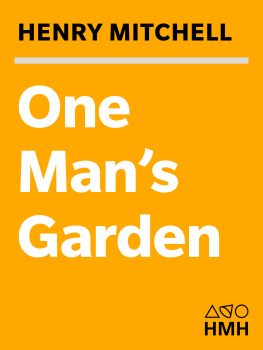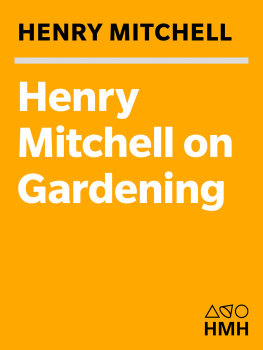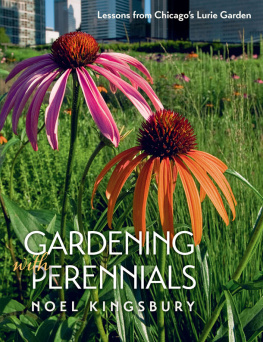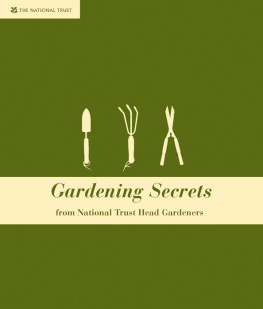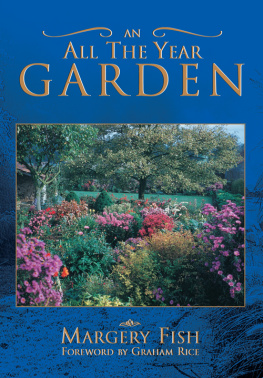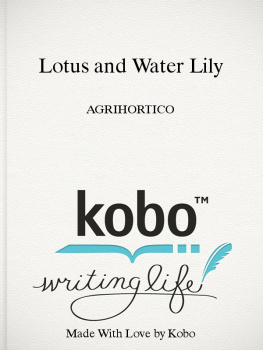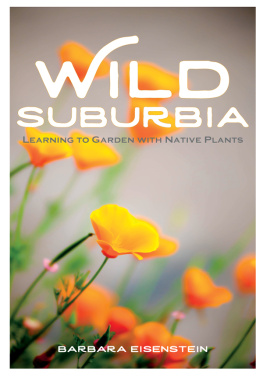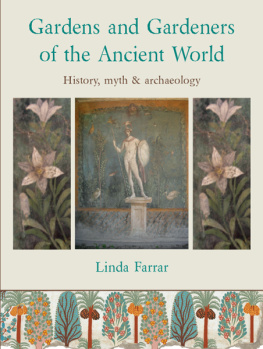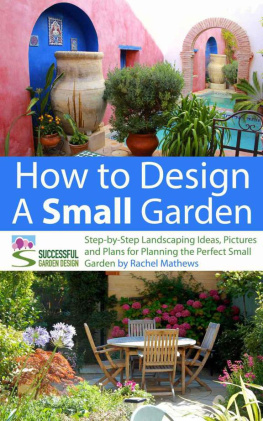First Mariner Books edition 1999
Copyright 1992 by Henry Mitchell
Illustrations copyright 1992 by Houghton Mifflin Company
ALL RIGHTS RESERVED
For information about permission to reproduce selections from this book, write to or to Permissions, Houghton Mifflin Harcourt Publishing Company, 3 Park Avenue, 19th Floor, New York, New York 10016.
hmhbooks.com
The Library of Congress has cataloged the print edition as follows:
Mitchell, Henry, date.
One mans garden / Henry Mitchell,
p. cm.
Includes index.
ISBN 0-395-63319-2
ISBN 0-395-95769-9 (pbk.)
ISBN 978-0-395-95769-1 (pbk.)
1. Gardening. 2. GardeningWashington Metropolitan Area I. Title.
SB 455. M 57 1992 92-11090
635dc20 CIP
Pen and ink drawings by Susan Davis
The material in this volume originally appeared, in slightly different form, in the Washington Post.
eISBN 978-0-547-34580-2
v2.0421
For Edna and Caryl Haskins
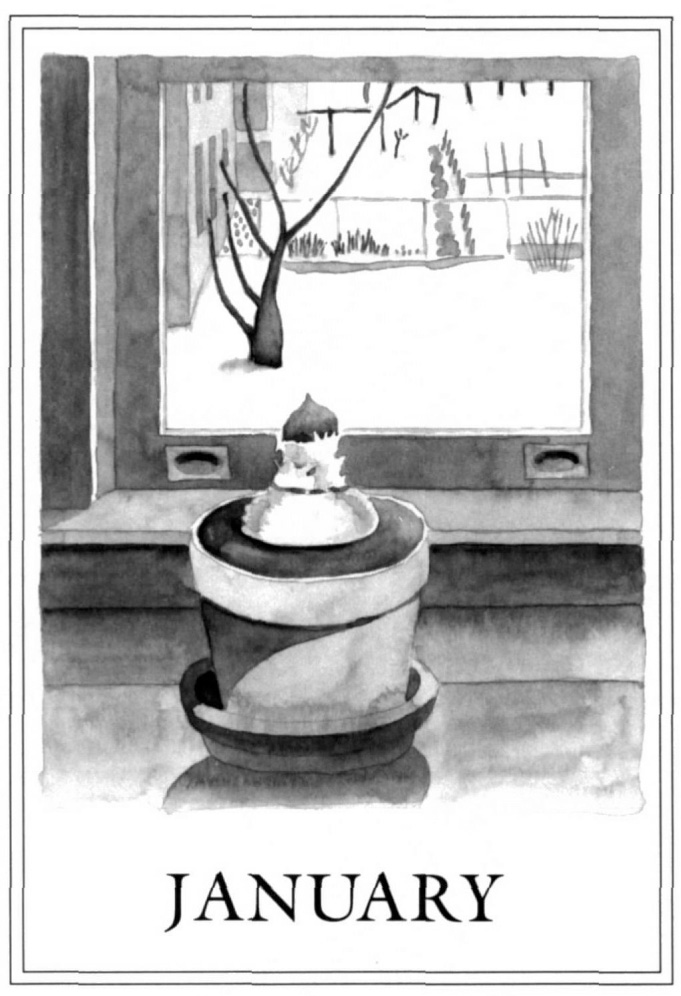
N O GARDENER needs reminding that life depends on plants. No plants, no life. Very simple. This rough and real fact is the basis for the gardeners awe of plants, and from this fact springs the gardeners anxiety about pitching out any green thing.
I have often advocated chopping down Norway maples, hemlocks, and other noisome trees that convert gardens into dank wastelands, so I am well aware that not every green creature should be cherished and preserved. All the same, we owe our life on this planet to plants, and there is no need to forget it.
There is no need for every American to be lured into gardening. It does not suit some people, and they should not be cajoled into a world they have no sympathy with. Many people, after all, find their delight in stealing television sets; others like to make themselves anxious with usury and financial speculation; still others rejoice in a life of murder. None of these is very good material for a gardener.
All I require of society, in the matter of gardening, is a decent awareness that gardeners have a greater stake in society than others, and an occasional reflection that no life is worth living without a vine and a fig tree.
Names from the Gardens Guest Book
A dear person, assisted by another dandy woman, gave me twenty-two plastic trash bags of horse manure for Christmas, and in last weeks mild weather I got it spread on particular treasures in the garden. Ten roses on their arches had first claim, followed by the planting site of ten forthcoming tomato seedlings, then a dab for a crinum that should have bloomed in the summer but didnt, and a handful for the Princesse de Sagan (a red rose sitting all by herself), and a bucketful for what I hope is a hardy palm. Like youth, horse manure goes all too quickly. Before youve got started good, its gone and you wonder how it went so fast.
This is the time to remind ourselves that we have our most beautiful skies in the winter. This sunrise the horizon was thundery dark gray-blue, surmounted by a broad band of orange salmon, then a band of turquoise, and above that a wide band of coral-rose. Above all that the sky was robin-egg blue with a few puffy clouds touched with light red. Of course only steady, wholesome folk (which includes gardeners) are awake to see it.
Many gardeners like to support wildlife in the garden, at least on a small scale, and this may be difficult, as the easiest fauna to attract in a city garden are rats. I once made a brush retreat (as recommended in a wildlife book) but had to remove it, as rats from a dozen counties soon applied for shelter. But I do keep bird feeders going, using only sunflower seed and suet (the suet in hanging wire containers), and as a result have many birds and of course squirrels. At first my peasant nature rebelled at the cost of feeding squirrels, but when I saw their ingenuity, determination, and general invincibility and then considered my own laziness, I saw that I would have squirrels forever and therefore resolved to love them. Things have gone smoothly since.
I put up a flicker nest box, which was taken over by starlings and then by a single squirrel, so I consulted books and built two nest boxes for squirrels. For two years they have ignored them, but on December 22 a pair moved into one of them, though it is only nine feet off the ground, and squirrels prefer to nest much higher. They carried in a lot of dried clematis stems for a couple of hours, and as they are just outside a bedroom window, we have an excellent view of their coming and going.
This past week squirrels have entered the second nest box, and several other squirrels have explored the first box. They stick their heads in until the occupant sticks his head out. A new black squirrel has investigated both boxes, and I only hope all this activity will not cause the original occupants to say nuts to it and move out.
Once we had a chipmunk, but not now. In a rotted maple we found a mother possum with five youngsters the size of oranges, but she was just passing through and stayed only two days. We had a raccoon who left dusty paw prints all over a newly painted wooden gate, and another one that came and destroyed a white water lily imported from Africa, after which we set a trap, but we only caught a neighbors cat. He was greatly put out when released but has continued to come back all the same, and through some unknown good fortune the coons have not.
We usually have at least a couple of pairs of birds nestingchickadees, Carolina wrens, cardinals, and mockingbirds. We also have eight mourning doves who come to feed. Usually a pair nests in the spring on a four-by-four wooden lintel, but the two eggs always fall off and the parents go elsewhere. Their nests are a disgrace, consisting of perhaps six twigs dumped at random, but they must be doing something right, as we now have the eight regulars and there were none when we moved in some years ago.
Nothing is better for wildlife in the garden than a fish pool. Counting sparrows, which we may as well since we have them coming out of our ears, we must have more than one hundred birds a day flying in to drink. Near us sea gulls feed at a grocery store, and I am just as glad they dont come to us and eat up the goldfish. Grackles I think do; I once saw one make off with a baby sparrow. Crows never came until the last year or two. I never catch them fishing but have seen them fly off with the glass thermometer that floats in the pool. Fortunately, I like to hear crows making a racket early in the morning, and love to hear the mockingbirds singing all night in May.
Butterflies abound in the summer, though no rare ones that I am aware of. Its said that if you take a big clay saucer, such as you might set a twelve-inch pot in, and fill it with mud kept constantly wet, you attract more, especially if a bit of horse manure is mixed in, but I have not yet tried it. Hummingbirds, I have learned, prefer several separate feeders, as they are bullies, and one will keep others from feeding.
A great sight is the pileated woodpecker that we have had visit on several occasions, once honoring us by looking at the rotted maple. Purple martins used to send scouts to look at the martin house but always flew on to the country, so we gave the house away. They do not like trees or tall shrubs near their house, and require plenty of space to whirl about in.
No foxes, nor, for that matter, tigers, but what we do have are agreeable occupants of a routine town garden that give great pleasure.
Architecture to Make the Garden Glow
Architecture is the mother art of gardens, not because a garden needs to be (or should be) cluttered with architectural gewgaws, but because the stuff of architecturethe tension between differing volumes, the fall of light and dark, the rhythms of textureis the essence of a garden.

